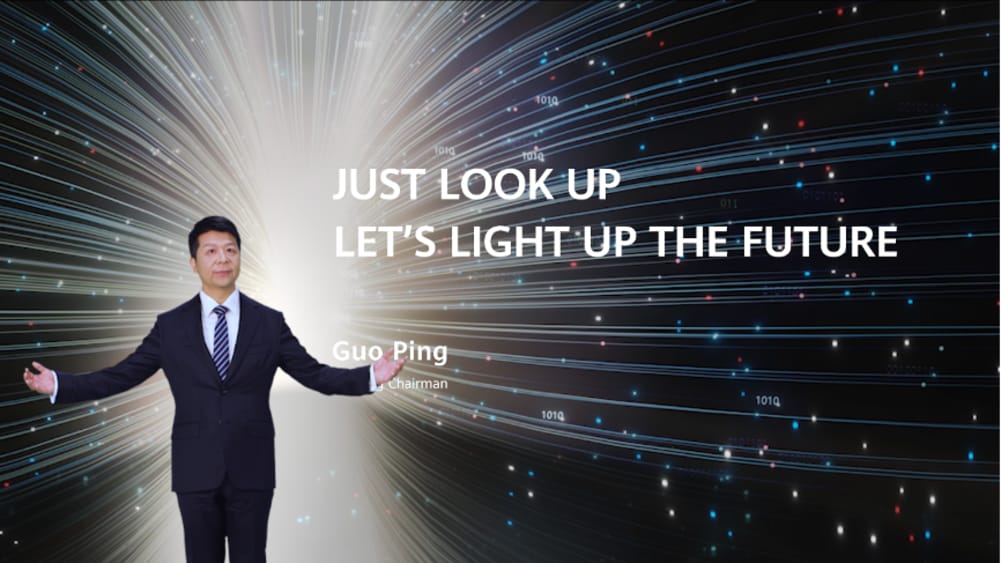
During MWC Barcelona 2022, Huawei’s Rotating Chairman Guo Ping spoke on the company’s plan to continue its globalization strategy and increase its strategic investment into foundational technologies. Through this investment, Huawei hopes to reshape the fundamental theories, architecture, and software that underpin its industry, increase its mid-to long-term competitiveness, and ensure the longer-term sustainability of the ICT industry.
In the keynote speech he delivered online, titled “Just Look Up, Let’s Light Up the Future,” Guo focused on two major sources of both challenge and opportunity in the world: digitalization and carbon neutrality.
Existing theories and architectures are unable to support explosive growth in digital demand.
Forecasts show that over 50% of global GDP will be digitalized in 2022. As the global digital economy develops rapidly, the demand for digital products and services has exceeded expectations. Guo explained that as Shannon’s theorem and the von Neumann architecture continue hitting severe bottlenecks, the industry must explore new theories and architectures to reshape the technological paradigm to achieve digital sustainability.
Carbon reduction impacts the long-term vitality of the digital economy.
On carbon neutrality, Guo said, “Connectivity density and computing power determine the strength of the digital economy, but it should also maintain long-term vitality. So, we need to consider a new dimension, carbon reduction.”
Huawei currently adheres to a “More Bits, Less Watts” strategy in this area. In addition to improving its fundamental digital capabilities, Huawei has committed to making its products 2.7 times more energy efficient by making breakthroughs in areas like theories, materials, and algorithms. Through advances like these, the ICT industry is able to help other industries reduce their own carbon footprints. In fact, this reduction will be 10 times larger than the carbon footprint of the ICT industry itself.
- Huawei is increasing strategic investment into foundational technologies to reshape the technological paradigm.
Guo also said that Huawei is significantly increasing strategic investment into foundational technologies and working with its partners to reshape the technological paradigm in three areas: fundamental theories, architecture, and software. This investment will gradually be reflected in the competitiveness of the company’s products, which they hope will support the long-term and sustainable development of both the company and the ICT industry as a whole.
This investment is also notably focused on helping the company get closer to and maybe exceed Shannon’s Limit. By exploring new theories and technologies, like next-generation MIMO and wireless AI, Huawei is able to push its technologies ever closer to Shannon’s Limit. At the same time, Huawei’s research into new theories like semantic communications will provide the industry with guidance on new fundamental theories.
Huawei is also developing exciting new architectures. Huawei is currently integrating photonic and electronic technologies and design peer-to-peer architectures to solve technological challenges or technique bottlenecks.
In terms of software, Huawei is building AI-centered, full-stack software and a new software ecosystem to meet the drastically rising demand for computing capacity caused by explosive growth of AI
- “Software-hardware synergies” will be the way forward.
Guo finally explained that great user experience comes from software-hardware synergies. He used two examples to show how Huawei applies this concept to ICT product development and technological innovation for network evolution. First, optimized algorithms for AHR Turbos are helping MetaAAUs consume less energy and improve performance. Second, algorithm breakthroughs in holographic optics have enabled OXCs to achieve one-hop connections.
- Huawei is the company with the most complete suite of ICT capabilities in the digital industry.
Over the last 10-plus years, network evolution has been a process of introducing the latest IT practices to CT, ranging from IP, to cloud, and then to AI today. As the company with the most complete suite of ICT capabilities in the digital industry, Guo said that Huawei is confident it will be able to gain a head start in the evolution towards future AI-native networks.
Closing out his speech, Guo said, “Huawei will continue its globalization strategy, in standards, talent, supply chain, and more. Huawei is committed to helping customers who choose it to achieve the greatest business success.”
MWC22 Barcelona runs from February 28 to March 3 in Barcelona, Spain. Huawei showcases its products and solutions at stand 1H50 in Fira Gran Via Hall 1. Together with global operators, industry professionals, and opinion leaders, we dive into topics such as industry trends, GUIDE to the Future, and green development to envision the future of digital networks. For more information, please visit: https://carrier.huawei.com/en/events/mwc2022



